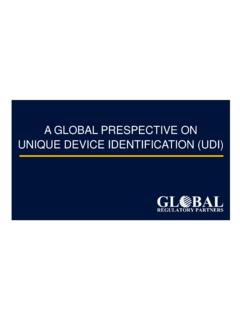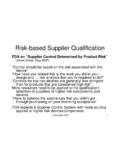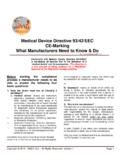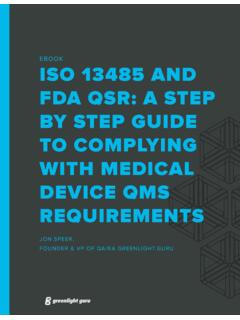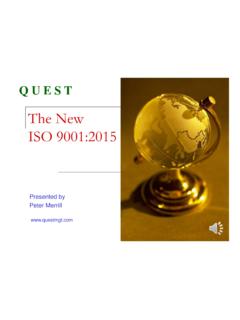Transcription of ISO 13485 2003 vs. 2016 - Global Regulatory Partners
1 ISO 13485 2003 vs. 2016 . On February 25, 2016 , the International Organization for Standardization (ISO) published its revisions to ISO 13485 replacing the previous version from 2003 . This is the Global standard for medical device quality management systems (QMS). Over the next three years, ISO 13485 : 2003 . and ISO 13485 : 2016 will coexist, allowing manufacturers, accreditation/certification bodies and regulators time to transition to the new standard. Per a draft transition planning guidance, organizations will still be able to be accredited for either ISO 13485 : 2003 or ISO 13485 : 2016 for the first two years of the transition period; however, after the second year, new accreditation will only be given for ISO 13485 : 2016 . After the third year, the guidance says, "any existing certification issued to ISO 13485 : 2003 will not be valid.". Regulators worldwide have integrated ISO 13485 into their Regulatory systems, including those in the US, EU, Canada, Australia and Japan.
2 The standard is sometimes adapted to meet local requirements, for example, EN ISO 13485 :2012 in the EU adds a forward and several annexes to the standard specific to the region. ISO 13485 is also used for the Medical Device Single Audit Program (MDSAP), an international effort to reduce redundant audits of medical device manufacturers. The ISO 13485 standard was updated for two key reasons: to keep up with changes in the industry and to address changes in the underlying ISO 9001 standard. While the old ISO 13485 . 2003 standard was based on the old ISO 9001:2000 standard, the new one is based on ISO 9001: 2008. Since 2003 , many jurisdictions had either revised or introduced new regulations for medical devices and these have been integrated with the new ISO 13485 standards. A few industries impacted by these changes are: Medical device manufacturers Accreditation bodies Certification bodies Registrars Regulatory authorities responsible for implementation and surveillance of medical device Regulatory requirements that will include the use of ISO 13485 : 2016 .
3 International and national standards bodies. Although the new standard is a revision to the original guidance, there are areas in which the standard had significant updates. The major changes between the 2003 and 2016 ISO standards include: Regulatory requirements While the 2003 standard expected you to establish a QMS that complies with ISO 13845, the 2016 standard explicitly expects you to conform to all Regulatory requirements. This requirement is emphasized throughout the new standard. In addition, it is expected that objectives are set for meeting both Regulatory requirements in addition to product requirements. Risk based approach The 2016 standard expects the application of a risk based approach to the QMS process. In the previous standard, risk was applied during product realization. In the new standard, risk management methods are applied to all QMS processes, including outsourced processes. ISO 13485 2003 vs. 2016 . Medical device file While both old and new standards expect the establishment of a special file for each type of medical device, the new standard defines this to include a description of the medical device(s).
4 Which will include all associated specifications, procedures and records. Record keeping The new standard expects Sponsors to record supplier monitoring and the re-evaluation of activities. Privacy regulations must be considered to protect confidential health information. Product realization In addition to the 2003 requirements covering product verification, validation, monitoring, inspection, and testing requirements the new standard has added product handling, storage, measuring, revalidation, and traceability requirements as well. User training The 2003 standard required the identification of product requirements specified by the customer and Regulatory bodies. The new standard sets an expectation that you also evaluate safety and performance of your products and associated training needs of the end user prior to supplying product to the customers. Regulatory requirements must be verified and user training is performed. Design and development inputs Risk management outputs must be considered to clarify product usability and safety requirements and to make sure that the input requirements can be verified and validated.
5 Design and development verification and validation Verification and validation plans must be verified, and to verify and validate medical devices that connect to or interface with other medical devices. Design inputs and outputs must be verified when devices are connected or interfaced together and to validate the intended use or application requirements when devices are connected or interfaced. Design and development changes The new standard addresses a few gaps with the old standard around how to control design and development changes. The new standard expects you to establish processes to control design and development changes and to evaluate their significance and impact. It also expects file maintenance for each medical device or family of medical devices that documents the changes. Design and development transfer The 2016 standard has established a specific design and development transfer subsection. Special emphasis is given to ensure that outputs are suitable for manufacturing before they become official production specifications.
6 Purchasing The new standard provides details on supplier selection and evaluation criteria. Now you must consider your medical device and the risks associated with the purchased products and the impact on safety and performance. You must ensure that your suppliers can meet the product, organization and all relevant statutory requirements. ISO 13485 2003 vs. 2016 . Supplier monitoring As part of your supplier selection process you not only must monitor the supplier performance, you must also consider the risk associated whenever suppliers underperform. The response and actions of supplier performance concerns must be proportional to the risk associated with the supplier's services and/or processes. The old and new standard both had requirements to establish records of the supplier's evaluation, but in the new standard you are also expected to record monitoring and re-evaluation activities Purchased product risks The old and new standards expect verification that purchased products meet purchase requirements.
7 But now consideration must be given to the risk associated with the product purchased and to worry about unanticipated changes made to these products. You must also determine whether these changes affect your medical device or your product realization process. Process validation The old and new standards expect you to establish procedures to validate production and service delivery processes that generate outputs that can't be verified until the product is in use or the service has been delivered. In the new standard, you must establish validation plans and to revalidate processes whenever necessary. Servicing In addition to the 2003 standard of documenting your organization's servicing procedures and reference materials, analyzing servicing records to identify servicing complaints and improvement opportunities has been added. Complaints The new standard includes requirements to include all complaints (not just customer complaints). You must develop and document complaint handling procedures that comply with all applicable Regulatory requirements.
8 The old standard simply asked you to establish arrangements, not procedures. Delivery of nonconforming product The new standard expects that delivered nonconforming products are investigated. You must determine corrective action and consider if notification must be provided to external parties ( , end-users, suppliers). Improvement Requirements for maintaining a suitable and effective QMS were required of both the old and new standard, but it is now required that you also maintain the safety and performance of your products whenever improvements are being considered. In addition, before implementing any corrective and preventative actions, you must verify that those actions comply with all applicable Regulatory requirements and that those actions don't compromise the safety and performance of your medical devices. Global Regulatory Partners , LLC can assist in the entire process of establishing a QMS. system to meet the ISO 13485 : 2016 standards. This includes the development, training, and ISO 13485 2003 vs.
9 2016 . effective implementation of your QMS to ensure successful certification. You can reach us at
